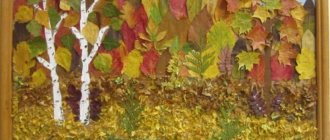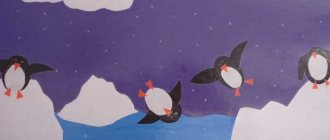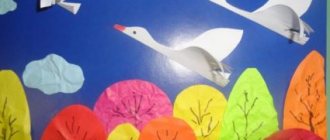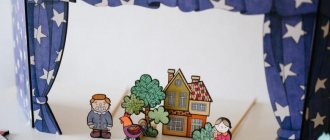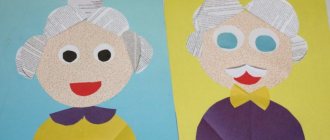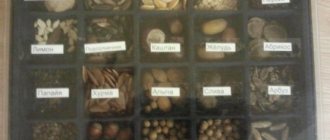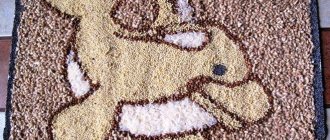Application is an excellent activity designed to comprehensively develop a child. Break applique is a separate direction. All age groups can use this technique, but it is most useful and interesting for children of primary preschool age. At this age, the development of fine motor skills is important for the development of a child, which this activity does an excellent job of. Let's look at examples and operating principles.
Bunny made of paper
To create such a craft, pre-prepared templates with images of animals are perfect. In the photo of the broken appliqué you can see a bunny; thanks to the use of this technique, an interesting texture is created, the character looks more voluminous.
To create beautiful crafts, you can take templates by cutting them out of magazines, old coloring books, or print them from the Internet. You can also draw the figure yourself on paper or cardboard.
Crafts technique:
- Tear off the paper strips and then finely tear them into pieces.
- Glue these elements like a mosaic onto a pre-printed or drawn image.
- Try to make small distances between the pieces so that they do not overlap each other.
- The nose and eyes can also be torn from dark-colored paper or drawn on.
- Makes a great craft!
Napkin paintings
Elements made from colored paper napkins give tear-off appliqués an unusual lightness.
Chick
Using a yellow napkin as a basis, you can make a cute chicken.
You need to prepare for the lesson:
- glue.
- thick paper or cardboard base,
- yellow napkin,
Operating procedure.
- Draw or copy the chicken design onto the base.
- Tear the napkin into small pieces.
- Attach it carefully. You can glue only the part of the element representing fluff.
- Draw the eye and beak.
You can make a delicate birch tree using a green napkin. Such work can be done by primary school students for a school thematic presentation.
Snowman
Prepare a sheet of white paper and draw snowdrifts on it.
- Tear them off with your hands, following the drawn line.
- Now cut it into two parts.
- Blue or light blue cardboard will play the role of a background; stick snowdrifts on it.
- Attach different parts on top of each other to make the result look more realistic.
- Make templates with snowman parts from white paper.
- Carefully tear off the blanks along the pencil outline.
- You can glue the resulting circles to make a snowman; try to put the bottom border on the snowdrift to “put” the snowman on the snow.
- Cut out a headdress for a snowman from colored paper, buttons and parts of the face can be drawn with felt-tip pens.
- Decorate the craft further as you wish.
Other application options
You can create entire paintings using the cut appliqué technique. This technique is perfect for children in the preparatory group of kindergarten.
You can tear off pieces, cut them and arrange them randomly. You can also beautifully outline the contours with markers or felt-tip pens and design an applique inside the image.
Using napkins for applique
If you tear a napkin into small pieces and stick it on, you will create a volume effect and the craft will turn out airy.
If you are doing a craft with the image of trees, the trunks are cut out or drawn, and the leaves will be light, made from napkins. Pieces of napkins can also be rolled into balls.
Application using cotton wool
- You will need a piece of cotton wool or cotton pads.
- You can give the children the task of tearing the cotton wool into small pieces.
- Draw images on a piece of cardboard.
- Pre-paint the cardboard or take a colored sheet.
- Decorate the background by gluing pieces of colored paper or painting it.
- Lay out and glue pieces of cotton wool inside the outlines drawn in pencil.
Using this technique, you can also create more complex images, where all the details of the composition, even the smallest ones, are made of cotton wool.
Step-by-step instructions: how to make a mosaic
To interest your child, you should choose a drawing for work that he will like: for example, a favorite fairy tale or cartoon character.
Options for quickly preparing material
For kids, it is better to prepare in advance all the details for a broken mosaic made of colored paper. Children do not know how to fix attention for a long time, and it is important for them to see the result of their work as soon as possible.
Older children can already prepare elements of the required size and color on their own. To make the work go faster, it is better to fold sheets for cutting or tearing in several layers.
An interesting effect can be achieved if you take colored pages from magazines or sheets of paper that the child hand-colored with color transitions.
As a material for a mosaic made of colored paper with your own hands for older children, you can use multi-colored circles punched with a hole punch (as well as stars and other details, if the hole punch is shaped).
Stages of work in creating applications from scraps of paper
How to make a paper mosaic with your own hands:
- Draw a sketch (or take a printed template), and think about how many parts you will need, and also decide on their size and color.
- Prepare all the elements by carefully arranging them in piles.
- Start gluing. There are two options here, depending on the age and perseverance of the author of the work: carefully coat each fragment and apply it to the right place, or apply glue to the entire surface and fill it with parts.
- After the glue has dried, the finished craft should be placed under a press so that it does not warp.
If there is no suitable color for the selected sketch of a collage of pieces of paper, you can color ordinary white sheets with felt-tip pens or paints.
Video master classes on working with children on the topic of mosaics
Volumetric composition
Do-it-yourself paper mosaics can be voluminous; to do this kind of work you will need:
- sample;
- a sheet of thick cardboard;
- glue;
- scissors;
- colored corrugated paper or napkins;
- pen rod.
You can roll up voluminous noses and eyes for animals from soft napkins and paint them in the desired color (you can also make the eyes yourself).
A lion made using the cutting technique.
Progress:
- Draw a sketch on cardboard (or trace a printed template).
- Cut the prepared material into strips about 1 cm wide, and then into squares.
- Take one prepared element and wrap it around the tip of the rod, squeezing the workpiece tightly with your fingers.
- Apply a dot of glue to the desired location of the drawing and attach a rod with a piece at the end to it.
- Carefully remove the rod - the workpiece should remain glued to the cardboard.
- In this way, the entire craft is assembled, trying not to go beyond the contours of the sketch.
An applique made from pieces of paper rolled into small balls looks nice.
From geometric shapes
Mosaics for children made from geometric shapes develop imagination and creative thinking well. To assemble the craft, you need:
- Cut into squares, circles and triangles, immediately placing them in piles according to shape, color and size.
- Choose a craft theme with your child (or offer him a pre-prepared idea).
- Lay out the parts on the table, forming them into the desired shapes.
- Carefully transfer the composition onto the cardboard.
Complex application for adults
An elegant mosaic made of paper twisted into spirals is called “Quilling”.
Applique tree
In order to make such a magical tree, prepare colored paper, a glue stick or PVA glue and cardboard or a sheet of thick paper.
- To begin, draw the trunk and branches of a tree on a sheet of paper and color them; you can print the finished image from the Internet or trace it using a template.
- Now tear off small pieces of colored paper and glue them in the form of leaves.
- You can use various shades of paper - your tree can turn out to be both autumn and magical.
- The applique will look neater if the pieces of paper are the same.
- You can apply glue to the sheet of paper itself so that you don't have to apply colored paper to each piece.
“Fox” applique made using the cutting technique
You will need:
- White base
- Chanterelle pattern
- Paper in three colors: orange, black and white
- Glue
Execution stages. Trace the stencil or draw the fox yourself on a white base.
Take orange paper and tear it into random pieces. Applying glue to each piece, we gradually fill the outline of the fox entirely. If the craft is being done by small children, it is better to cover the entire chanterelle - the base - with glue and stick the dry pieces from bottom to top.
Tear off two small, approximately identical pieces of black paper—the eyes—and glue them onto the fox. Another part will be needed for the spout. Tear off a small piece from a white sheet and make the tip of the fox's tail. Our fox is ready.
You can also not prepare pieces of paper in advance, but tear them off from the strip at the gluing site. Watch the video to see how this is done.
Landscape made of paper
In order to create an entire landscape using the cut-out appliqué technique, you will need several sheets of colored paper, as well as pencil glue and a sheet of cardboard as a base.
- Now the most fun part of the job is tearing and crumpling colored paper.
- If you use crumpled paper to create a composition, it will look even more interesting and voluminous.
- Now you can collect parts for a future application.
- Develop your child's imagination by asking him what a piece of paper looks like.
- This way you can find creative and unexpected solutions.
- In addition, for children this is a real game, so the creative process will become even more interesting. If you have already outlined the elements of the picture on a sheet of paper, you can safely glue the details to the base.
- Attach the corners first so you can experiment by moving the paper pieces around.
When the picture is ready, carefully glue all the parts and let them dry thoroughly. The picture is ready, you can decorate it if you want and put it in a frame.
Principle of operation
Paper crafts using the cut appliqué technique are made in 2 main ways.
Simple option
This option is suitable for the youngest children.
The stages of such creativity are as follows:
| № | Stage | Description |
| 1 | Preparing the template | At the initial stage, an adult (parent or teacher) must select a drawing suitable for the work - an outline on the basis of which the craft will be made. In this case, you can take a ready-made drawing or draw it yourself. When there is a background, all that remains is to put a picture on it. Its elements are torn off from colored paper and then glued to the main canvas. It is important to keep in mind that a large number of parts will be glued to the top of the canvas. |
| 2 | Selecting Colored Paper | The paper that serves as the background for this craft must be thick enough, so when choosing, you should pay attention not only to the color of the base, but also to the thickness. Children can be involved in the work. Along with them, you can choose the color of the paper that will be used for filling. After this, the child himself begins to tear off pieces of any size. |
| 3 | Gluing paper to background | It is necessary to take each piece of paper, apply an adhesive substance to one of its surfaces, and then apply it to the base one by one. It is most convenient to use a glue stick, because with its help you can evenly distribute the adhesive over the surface. When the space is filled, the work is completed. The result is a monochrome product, much like a mosaic. |
The option is more complicated
Cut-out paper applique (templates for products can be classic or abstract) always starts with an idea. After choosing a suitable example, the child begins to do everything independently, but at the same time, an adult must supervise his creative process in order to prevent mistakes.
Tear paper applique on a fairy tale theme
The stages of the complex version are as follows:
- Take thick colored paper. It can be any color.
- Attach a stencil to thick colored paper and trace it. If desired, you can apply a design to the surface of the paper without using a stencil.
- Select thin paper of the desired color and start tearing pieces from it.
- Fill the space with torn paper pieces. To do this, an adhesive is applied to each fragment; it is best to use a glue stick.
- After filling the entire space, the work is considered completed.
Decoration of the composition
When the painting is ready, you can decorate it using all kinds of materials to give it a finished look and make the work unique.
- A few shells, dried flowers and leaves, ribbons, bows, buttons, beads, beads, rhinestones are perfect for this (adults should supervise the children’s work, especially if small parts are used in the process of creating a masterpiece).
- The resulting creation can be inserted into a beautiful frame. And then the child can safely participate in competitions with his works.
All these ideas will help you and your children create real masterpieces using a minimum of materials. And most importantly, this is a very fun and interesting process that can become leisure time for the whole family.
The finished work can become a wonderful interior decoration, and you can also present it at any children's craft competition. Such educational crafts will be very useful for teaching in kindergarten.
There are a lot of different techniques of varying complexity; you can choose something suitable for the creativity of children of different ages, from the youngest to the preparatory group.
Cotton wool applique
original flat crafts can be easily assembled using the peeling technique using pieces of cotton wool. It holds up well and is easy to work with.
Swan
An elegant figurine of a swan can be placed with particular success on a cardboard base made from pieces of soft cotton wool.
To work you need to prepare:
- cotton wool
- base,
- glue,
Operating procedure:
- Draw a swan based on. It is better to take a blue or light blue background.
- Tear the cotton pad into small pieces.
- Attach it carefully.
- Draw the bird's eye and beak.
Using a similar technique, you can make winter-themed applications: snowman, spruce, snowfall. A kitten, a cloudy sky or a rabbit will look great.
An independent application is not only an interesting, but also a useful form of children's creativity for a child. Promote diverse development and interest in children of different ages.

